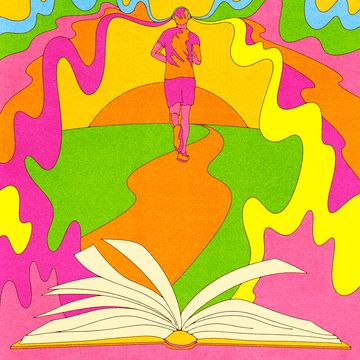Bernard Lagat trots up the hill from his summer home in the Lustau neighborhood of Tubingen, Germany. He passes apple orchards, fields of potatoes and corn, ripening wheat, a farm selling buttermilk. He enters dense woods, part of the Naturpark Schonbuch. "It's golden in October," he says, growing ebullient the moment his feet touch the moist sand of its trails. A map shows seven different loops. "You can go 13 miles in here and not repeat." A small smile creases his face.
It is an August afternoon last summer, a week before the first round of the 1500 meters in the track and field World Championships in Berlin. The day before, Lagat had gone to a nearby track where he ran a pitch-perfect workout. He clocked one minute and 20 seconds for 600 meters, followed by three 41-second 300s. The times were identical to the training runs he had completed before the last World Championships, in 2007, when he went on to win both the 1500 and 5000 meters. So, based on yesterday's workout, he is heartened. He hasn't lost a step.
Now, amid the beeches, maples, and ash, all he must do is run gently, to get the juices flowing, to allow the previous day's work to take full effect. It's humid, so he sweats even in the cool shade, giving his carefully shaved pate a high gloss. "If I let my hair grow," he chuckles, "I'd still be as bald as a village elder."
When Lagat makes this point, it dawns on a visitor what a startling contrast there is between his youthful potency and his well-disguised age—a contrast few athletes of his stature ever get to achieve. Peter Snell of New Zealand, after winning the Olympic 800 meters in 1960, and the 800 and 1500 in 1964, became a research scientist so as to study his own kind—the great. He found that champion middle-distance men have only been able to endure racing and training at their peak for an average of five years. That was all Snell himself could stand.
Bernard Kipchirchir ("Call me Kip") Lagat is now in his 12th season of being ranked among the finest milers and middle-distance runners in the world. You cannot retrace the Kenyan-born American's magnificent career without crying out, ever more jealously: Just how? How can he still compete at the highest level when his bronze in the 1500 meters in the Sydney Olympics was a decade ago? How can he still be a threat when he ran his best time, 3:26.34, the second fastest 1500 ever, back in 2001? How could he not be sated after he took silver in the 1500 at the 2004 Olympics in Athens? How does he continue to win the Wanamaker Mile, the most famous indoor mile in the world, year in, year out (seven straight and counting), when younger runners with younger legs are chasing him? How on earth did he keep right on after becoming a U.S. citizen and winning the world 1500- and 5000-meter championships in 2007? How does he stay so eager when the champions he battled, including the most notable, Morocco's Hicham El Guerrouj, have long since quit?
True, when Lagat failed to make the 1500 final in the 2008 Beijing Olympics, he looked done at last. Not only that, he had taken on more and more draining responsibilities. He was pushing 34. He had a toddler and another on the way. He had a charitable foundation to look after. His career had to be over.
Then he confounded us again. He tore up the early 2009 European season and proved he had a shot at defending his world titles in Berlin. Moreover, his manager, James Templeton, said he would be a contender in the 2012 Olympics in London. This, finally, was outlier crazy. This was inhuman. This made you wonder if there is anyone among us who couldn't use an object lesson in holding mortality at bay. This demanded a visit.
Lagat has trained in Tubingen since 1998 because Templeton bases his stable of runners here during European summer seasons. Within the Schonbuch woods Lagat has retooled his techniques, again and again, continuing an education and an evolution that allows him to endure beyond his age. Often the lessons don't end perfectly, as the coming meet in Berlin will attest. But for this runner, the quest can be as memorable as the results, and often as comforting as these woods. "They remind me of home," Lagat says, thinking of another forest, another country. The trail, with Teutonic compulsiveness, is so level and groomed that he could rip along at racelike pace if he wanted to. But he doesn't. He just trots at six-and-a-half-minute pace. He just savors. "I can run free here," he exults. "I can go back to being a kid."
And to understand what keeps Bernard Lagat running and competing, when age and science say he should be done, we have to go back, too.
Bernard Lagat is a Nandi. He was born on December 12, 1974, in the village of Kaptel, elevation 6,500 feet, in Nandi District, Rift Valley Province, Kenya. Stride through the area and you will forever dream of undulant tea plantations, rushing eucalyptus forests, and cobalt African skies. The sound of human voices is everywhere. They lift, soft and high, from every slope, testimony to the density of humanity here and its youth. Gaze across the land and you catch movement, sheep and goats at first, then children in dirty sweaters, running over the hillocks and fields of drying maize, the corn used to make ugali, the staple of the Nandis. Ugali is porridge, bland and scratchy on the palate. It goes with any sauce, and is immensely satisfying, its carbohydrates the right complexity to restore and strengthen tired young muscles.
The kids and their sustenance are part of a culture that evolved in a way that happened to enable runners—as did the Nandi obsession with the cow. Their incessant raids for cattle created a culture in which reputation, wealth, and progeny came to fighting men who could cover long distances quickly. Nandi warriors became not explosively muscular but lean and tireless.
In the late 19th century, the British colonialists found Nandi raiding parties ranging more than 100 miles from their villages, striking at night and driving cattle miles toward their home before enemy warriors could regroup. The Nandi were so fierce that it took the British five military campaigns over 10 years to subdue them in 1906. To keep the Nandis from further raiding, the British asked them to sublimate; to substitute sport. "They jailed the raiders and put them to work making running tracks," says John Manners, a former Peace Corps teacher in Kenya who has studied the Nandi and related groups. "Because the Nandi were such frequent offenders, they got a disproportionate number of tracks."
To make a man who can run a hundred miles on a bowl of ugali and a spurt of cow's blood, the Nandi employed powerful means. The most potent was ritual circumcision. To come of age in much of East and South Africa, a boy between 12 and 20 must command himself to remain stoic while his foreskin is ceremonially cut away. "The boy's face is carefully watched by the surrounding crowd of warriors and old men to see whether he blinks or makes a sign of pain," Manners relates. "Should he in any way betray his feelings, he is dubbed a coward and receives the name kipitet." This is such a disgrace he may never be allowed to marry and set up his own household.
Boys are prepared with weeks of seclusion and instruction in the ways of the tribe. "Circumcision parallels what the military does to a draftee," says 1972 Olympic 800-meter bronze medalist Mike Boit. "The elders shave his head, give him a new name, and subject him to rigorous discipline, all to remove his individuality and replace it with a new identity of toughness and obedience." The result is men who do not shrink from the discomfort of running, or much else.
Bernard Lagat is one of those men. He was the fifth of 10 children born to Richard Kiplagat Leting, who farmed 26 acres. Every morning, Bernard walked or ran a mile and a half to Kipsirwo Primary School, ran home to gobble his ugali for lunch, ran back to school, then ran home again to study and do chores before dinner. After such a childhood, after such unbidden cardiovascular development, formal athletic training is just a final polish.
Living leanly on the farm, Lagat had no sense of privation. Just the opposite. He was loved and protected, and, in his characteristic, quiet, observant way, realized a great calling was right next door. Nearby Kapsabet's track is the epicenter, the source of Nandi running greatness. Their primal champion, Kipchoge Keino, the 1968 Olympic 1500-meter victor and 1972 3000-meter steeplechase champion, raced here. It was here that Henry Rono, watching Keino from afar, made his vow to be a runner. In 1978 alone, Rono took down four world records.
All the Lagat children were urged to enter community races because they could win blankets or axes or roofing material. Bernard saw that this could lead to bigger things because in 1984 his sister, Mary Chepkemboi, won the African 3000-meter championship. Bernard was then 9. He impressed Mary with his intelligence, and she him with her discipline. She ran every morning, before milking the cows and washing the dishes and heading to school. "I wanted to be just like Mary," he says. "She made everything seem possible. I listened to her."
He also followed the rituals of his people; he was circumcised at 14. "It is very true," Lagat says, "that being Nandi was vital to what I became, and that has to do with being a man. I went through my rite of passage in 1988. Before that, I was a boy. Before that, I was Bernard Kipchirchir. After that time, men looked at me as a man. After that, I could add 'son of Lagat' to my name. When you are no longer a boy, you have to be tough. No matter how painful something is, you have to take it. I saw that in both my parents. I only had to observe them to learn toughness. But the essential thing in Nandi society is not simply enduring. It is also always finding a solution." One does not simply suffer in silence. "You seek help from the elders. A society with elders is healthy. It's not always that way in the West."
In 1992, when Bernard was a sophomore at Kaptel High School, Mary gave him his first pair of running shoes, saying he had to train harder now. He did, a little, but was far from the best. In the 1994 Rift Valley provincial schools championships, he was beaten badly by future 3000-meter world record holder Daniel Komen. Lagat had the good fortune, in this cradle of prodigies, not to be one himself. He would not burn out early.
Not that he was talent-free. He was simply one of hundreds of Kenyan kids who ran with pretty strides but didn't train seriously. His defining trait, at this defining point in life, was not physical. It was that he trembled (and trembles still) with the importance of education, of learning all he could from his teachers and elders. If there is a theme to Lagat's story, it is a classic balance, training both body and mind as they allow. Whatever promise he showed, in whatever calling, he burned to fulfill.
Indeed, because of that, his future seemed to bend toward the academic. He graduated from high school in 1994 and was accepted by the prestigious Jomo Kenyatta University of Agriculture and Technology (Kenya's MIT). He began real training with the coach there, Ng'ang'a Ngata. But he knew by then that he wanted to try for an American university. He explored the idea with John Manners's daughter Jane, whom he met in 1995 when she was in Kenya teaching for a summer, but he held off.
In 1996, he showed he had a true future in running. Training with Ngata, Lagat ran a sparkling 3:37.7 1500 meters to make the final of the Kenyan Olympic Trials, but didn't win a place on the team going to Atlanta. Still, a 3:37 will get you ushered into any college in the United States, so now he had options. Ngata began telling him of an American university, Washington State, where Rono had blossomed. That fall, Lagat accepted a scholarship there—and then soon found himself 15,000 miles from home, in the farmland of eastern Washington state, and in the hands of a mystical Chinese coach with revolutionary ideas on how to turn a wide-eyed Kenyan into a world-class miler.
Whether at the end of a private run through the woods of Tubingen or bolting ahead of the pack on the track, Bernard Lagat is unmistakable. The movements that combine to form his light, quick stride are supremely efficient, letting him husband optimal energy for his finish. But he wasn't born that way. His stride took honing. It was the work of a master technician.
James Li was born in China in 1961, son of a metallurgical engineer. He grew up in the turmoil of the Cultural Revolution, Mao's purging society of intellectuals. His mother was detained briefly, accused of being counterrevolutionary. Li ran the 800 meters very well in college, at Beijing Institute of Physical Education. In 1984, he was working at Sichuan Sports Institute when John Chaplin, the track-and-field coach at Washington State, paid a visit. When Chaplin's interpreter couldn't translate "starting blocks," Li stepped in and made a powerful impression. Chaplin offered him a graduate assistant post at WSU while he got his masters and Ph.D.
In 1989, Li was about to head back to China with his degrees when the Chinese government showed the world in Tiananmen Square that it wasn't ready for political freedom. Li, knowing he couldn't celebrate individuality the way he wanted to in that environment, stayed in the States, doing a stint as head track coach at Mankato State, before returning to WSU in 1994.
Li had never trained a world-class miler, but he had been preparing for years, in part because he had been enthralled by Roger Bannister's account of breaking four minutes in 1954. "It hit me as a genuinely spiritual thing," Li says. "I've always coached with the understanding that what we do is a coming together of mind, spirit, and body." With Lagat's arrival in Pullman, Washington, in August 1996, though, Li encountered a 21-year-old man in conflict, transitioning between climate and culture, between a familiar, beloved home and a cold, alien place. "He had never experienced a temperature below 40 degrees in his life," says Li. "And he had to adjust to strictly scheduling school work and a new training system. He had to form a whole new set of relationships." But he was a Nandi. He didn't just suffer. He sought solutions. "He did great," crows Li. "He made new friends, he made good grades, and it was him who did that. It was that unflappable character from the start."
By the end of his first cross-country season, Lagat was already showing his skills. He placed seventh in the PAC-10 championships, and Li knew he had a rare gift: a runner able to race much faster than he trained. "I saw he has that kind of head," Li says. "When the big meets come, he delivers."
Fortunately for Lagat, he was being coached by someone who had learned the lesson that every athlete is different, with varying metabolic and structural gifts. Li knew from what he had seen in China, where unrelenting coaches assigned huge mileages and stunning volumes of intervals, and in the process damaged their runners to no end. It took a certain bravery to uphold the idea that if you just keep a runner healthy, he or she will naturally improve.
The mutual education of Li and Lagat took a while. "I soon figured out what kind of running benefits him most," Li says, "which is not too many miles, plenty of recovery. But he didn't run close to his 3:37 PR that first year. [He had to adjust] to running a lot of races in the collegiate year, the big relay carnivals, the indoor nationals, the outdoor nationals..."
In 1997, Lagat's best 1500 was only 3:41.19. But in the winter of 1998, he ran a decisive leg on WSU's winning distance medley relay in the NCAA indoor championships. That summer, he entered a world-class 1500 in Stuttgart, Germany. "Most painful race of my life," Lagat recalls. "They took off so hard it felt like sprinting all out. It hit me. This is what 3:30 pace is." He fell to the back and staggered across the finish in 3:34.48, a three-second PR.
Lagat called Li: "Guess what I ran?"
"3:34!"
"How'd you know?"
"I know what you can do!"
When he got home, Lagat was a changed runner. "Kip talked about that 3:30 pace, and how he knew the difference now," Li says. "That's the runner's own tenacity. What you build on."
It must be observed, too, that 3:30 pace is sprinting. That is 14 seconds for every 100 meters, meaning splits of 56 at 400, 1:52 at 800, 2:48 at 1200, and 42 for the last agonizing 300. And that's not even world-record pace. Hicham El Guerrouj's 3:26.00 is 55-second 400s all the way.
In refining Lagat's training, Li conferred with his mentors. "I've had several," he says. "Coach Chaplin, of course. Bill Dellinger at Oregon was very generous with me. I have a monthly lunch with coach Joe Vigil (the former coach of Olympic bronze medalist Deena Kastor). I sat with Bob Larsen of UCLA at the Mt. SAC Relays and shared my puzzlement with athletes in general. My question was, where is the correlation between great interval workouts and racing well? Because a lot of guys do one but not the other. He said he had found tempo runs helping his guys. I tried it, and it helped mine." It sure helped Lagat. Tempo running is sustaining a pace near the edge of one's aerobic capacity, not as hard as racing, in a zone around 90 percent of maximum heart rate. Lagat would become famous for doing tempo runs of 5000 meters or longer on the trails.
After winning both the mile and 3000 at the 1999 NCAA indoor meet and then the NCAA 5000 outdoors, Lagat forfeited his final year of college eligibility. He asked Templeton, a successful agent for other Kenyans, to take him on. Templeton balked at first because Lagat was still a few seconds slower than his big guns. He let him in because of his radiant calm. "He thought I'd be a good influence on the other Kenyans," Lagat says, laughing, "but he didn't think I was going to really be good."
He was really good. That summer, at a meet in Zurich, Switzerland, he set a U.S. collegiate record of 3:30.56 for the 1500, and by the end of 1999 he was ranked fourth in the world by Track & Field News. He earned a shoe sponsorship from Puma (which he used to build a house for his parents in the Rift Valley) and unprecedented options. He could have returned to Kenya a celebrity or stayed in Europe. Instead, he went back to WSU, sticking with what had gotten him to the top. He would earn degrees in management information systems and decision science.
In 2000, Lagat made the Kenyan Olympic team in the 1500—whereupon Li developed a natural concern. Lagat had long known Gladys Tom because she was a student trainer for one of the other WSU teams. But she didn't date athletes, and she didn't date him until he was out of school. Now they had grown so close that Lagat wanted her in Sydney. Li worried that Gladys (whom Lagat would marry in 2004) could be a distraction. All turned out fine. "Gladys was tremendous for him. He ran 3:32.44 and got a solid third behind Noah Ngeny (3:32.07) and Hicham El Guerrouj, and we realized he has something in his head to be able to handle anything. The question is, can you teach that? I don't think so." Well, maybe you can, but it helps when your student is a product of the Nandi tribe.
Lagat was now the Olympic bronze medalist. It hardly slaked his desire to keep improving. It was time for Li to teach him the kick that would become his signature stroke. They didn't do it with more sprint work. "If a runner can cover the last 200 in 25 seconds," says Li, "he'll dominate the 1500. Well, most college milers can do 25 easily when they're fresh. But in the last 200 of a 1500, it's not your absolute speed, it's your ability to kick when tired. So I attribute his improving kick to how strong he got over the years. That let him develop a magnificent turnover late."
Lagat was now ready to play a major part in the greatest era of middle-distance running in history. Sadly, he would also be pulled into its sordid aspects as well.
Olympic runners so lust after improvement and its elevating glory that theirs is a world of incessant temptation. Part of Lagat's essentially spiritual approach was to eschew all performance-enhancing drugs. Part of his education, therefore, would come in the form of a blindsiding ordeal.
Just before the 2003 World Championships in Paris—where Lagat, now with a 1500-meter PR of 3:26.34 was set to take on El Guerrouj and his world-record time of 3:26.0—an official gave Lagat a letter informing him that he had tested positive for erythropoietin (EPO), an injectable red-cell boosting hormone forbidden because it increases stamina. "I grabbed that letter and said, 'Don't even joke like that.' Then reality sank in. I cried until I got sick." He was suspended, pending a test of his B sample. For five weeks he was in moral agony.
"My defining story for Kip is how he handled Paris in '03," says Manners. "I'm sure he was clean because two weeks before he'd been given a blood test, but was absolutely unconcerned. He had brought his parents to Paris—their first trip out of Kenya—not something you'd do if you were afraid of being disgraced. His only worry was how to get them passes to the meet."
Lagat didn't even take supplements, and had a needle phobia. "I was running my best clean," Lagat says evenly, suppressing his fury. "Why would I ruin it?" He was barred from the Worlds.
"It shafted him internationally at the height of his career," says Manners. "But he was always calm, determined, focused, the exact opposite of what I'd have been. He was the embodiment of the Nandi warrior. You don't behave like a child. You don't raise your voice, you act like a man, and that was him."
Five weeks later, he was vindicated. His B sample was negative. But the ordeal was such that he couldn't shake it off easily. For months he wondered why this had happened to him. There were millions out there who had read that he was a doper. Could he ever rebalance the scales? Should he quit?
"Coach Li said, 'Prove to people you are a man of dignity by running faster,'" says Lagat. "Part of the solution was coming back stronger than ever in 2004. So I used that experience."
In January 2004, he was being introduced at an indoor meet in Boston. The crowd stood and roared. "They welcomed me like an American," he says. "I almost cried." Four months later, in fact, he was an American. On May 7, 2004, he became a naturalized citizen, but he didn't make that public. Had he done so, Kenya could have kept him from running in the Athens Games that summer—and in his final major showdown with El Guerrouj.
Before those Olympics, El Guerrouj was in a strange position. He was the fastest ever, but events had conspired against him in Olympic 1500-meter finals. In 1996, he had been tripped with a lap to go and finished 12th. In 2000, heavily favored, he had been outsprinted by Ngeny. So Athens was his last chance to rescue his legacy. There was no more deserving favorite. Or cofavorite, because Lagat was as prepared as he had ever been. Eighteen days before Athens, Lagat ran a 3:27.40 at a meet in Zurich, narrowly defeating El Guerrouj, who ran 3:27.64.
Both survived the Olympic prelims in style. In the final, the pace was so fast that neither had to worry about being boxed. Lagat stayed on El Guerrouj's shoulder throughout, then pulled even after the last turn. But El Guerrouj would not bend. He dug deeper, and pulled ahead. He beat Lagat by a meter, 3:34.18 to 3:34.30. Lagat was the first to congratulate him.
"I think on the outside Kip was happy for Hicham," says Li, "but when I thought about it, he could have won it. He should have moved a little later."
They determined that there were miles to race before Lagat was done. He couldn't contest the 2005 Worlds because he was ineligible due to switching nationalities. That made it all the sweeter in 2007, in sultry Osaka, Japan, when he won both the world 1500 and 5000 titles. They were his first international gold medals, and the first ever by an American in those races. "I am so happy," Lagat said at the time, "to be of service."
The luck of Osaka didn't last. The next year, Lagat won both his events in the U.S. Olympic Trials in Eugene. "But on July 11, 2008," says Li, "a week after the Trials, in that very forest in Tubingen, he went for a run while I waited in the parking lot and came back and said, 'Achilles sore.' He had to back off training just enough that he could never quite catch up. He was still doing hard training during the Games." He didn't advance beyond the 1500 semifinal, and ran ninth in the 5000 final.
It was no effort at all, then, to rededicate himself to redemption in the 2009 Worlds in Berlin.
Tubingen reminds me of Oregon," Lagat says on this August day. "It's a college town and is environmentally friendly. But it's stricter. You have to put the right thing in the right receptacle. A guy yelled at me once when I was warming up the car as I stretched after a long run. I couldn't figure out why he was furious. That week I asked all my friends what that could have been about. One of them said in horror, 'Oh my God, your car wasn't running, was it?'"
Lagat and Gladys have a son, Miika, who is 3, and a daughter, Gianna, who was born in the fall of 2008. Gianna is beautiful and serene, not an immediate smiler, as is her big brother. On this day she is on the verge of walking. Lagat dislikes running or racing early in the day, and often slumbers until 9. This is possible because Gianna sleeps through the night.
"Miika loves to teach Gianna how to play in the morning, in his room with toys," says Lagat, who it seems is always grabbing the kids and hoisting them up. Miika is huge for his age. Bernard was once asked if his son was his little brother. The family has put pictures on Twitter of their trip to Morocco where they rode a camel. "Miika now has more than 50,000 miles on his frequent- flier plan," says Lagat.
Later, at the track, before Lagat's last interval workout, the kids pile on to help him stretch, Miika pounding on his foot, Lagat giggling. What is that neurotransmitter that makes for love and trust and bonding? Oxytocin? If you want to know how it looks when it surges through a system's every receptor, it is the sight of Lagat with his children. It's a happy man who recovers best. "They've made me much more mellow in the hours before a race," he says. "Gladys now has to tell me, 'Hey, time to get serious.'"
The next week he is all business during his 1500-meter semifinal. Lagat moves wide on the last backstretch to make room for teammate Lopez Lomong, and they both advance. When Leo Manzano finishes a gutsy second in the second semi, Lagat yells, "What a team! Three Americans in the final!"
"There are two types of 1500," Li says ominously afterward. "The Grand Prix races where you set it up with pacemakers, going for times. And the Olympics and the Worlds, when it's every man for himself and nobody wants to lead." Lagat has long since become a master tactician, avoiding boxes, staking out a position near the front, drafting on those ahead, yet free to react to others' moves. "But there's no real telling what a bunch of amped-up milers will do under pressure," Li offers. "No guarantees."
Two days later, Lagat stands waiting to go to the line. The TV camera that is thrust in his face reveals a startlingly serene visage, ready for anything. Because he is in lane one, to prevent being caught in the pack early, he has to choose between a fast start or a drop into last. He chooses the fast start, and is running safely in second behind Augustine Kiprono Choge of Kenya, who leads past 400 in 59.54 and 800 in 2:00.18. A modest pace, which means the pack is running in a tight clump. At the top of the backstretch, with 300 to go, Ethiopia's Deresse Mekonnen cuts loose into the lead, bringing a swarm of men with him. Lagat is a close fifth with 250 to go, but gets horribly boxed on the last turn. He is as far back as 12th in the melee. Into the stretch, he sees an opening, cuts sharply to his right, finds freedom in lane three, and gains all the way home—until he runs out of time. Yusuf Saad Kamel of Bahrain wins in 3:35.93. Mekonnen is second in 3:36.01, and Lagat third in 3:36.20. He loses by the same two meters he had sacrificed in order to get free.
"I should have known better," he kept saying after the race. And he kept being told that he didn't have eyes in the back of his head. Once the mob was past, they were past. But then his mood lifts quickly. "It's disappointing, but I beat a lot of good guys today."
By the time he reaches the postrace interview, he is magnanimous to all, congratulating Mekonnen on winning Ethiopia's first Worlds or Olympic medal in the 1500. "I feel great, physically," he concludes. "I just got caught in a box. On to the 5000."
The prime opponent there is only the best distance runner of our era, world-record holder Kenenisa Bekele of Ethiopia. Bekele cannot be fresh, not after a great battle days earlier in the 10,000 with tough little Zersenay Tadese of Eritrea, who made him run the last 5000 in 13:06. But Lagat has another stroke of bad luck. In his semi, he was spiked, suffering a cut on his ankle. "The doctor put stitches in, but it was so deep that the next day he couldn't run at all," Li says.
There were two days between semi and final. Lagat could only slow jog and walk for 20 minutes the day before the final. Still, he tells his coach, with all his quiet resolve, "I am not giving up on this race."
"The doctors said they could give him a local anesthetic at the spot for the race," Li relates, "but then the team physician took so long coming back from the women's marathon, it was a panicky, last-minute thing. I did not think he would run well at all."
His opponent, Bekele, knows none of this. What he knows is that his best 1500 is 3:32.35, and Lagat's 3:26.34, so his worry is to not go out too slow and risk Lagat's fierce kick. In this race in 2007 the field had dawdled, and paid for it as Lagat happily kicked past everyone.
Bekele's tactics, therefore, are an homage to Lagat. He leads, doing 67s for the first five laps of the 12-and-a-half-lap race, then throwing in a 61. He lets three Kenyan runners take over for a while, but when they slow at 3000, he retakes the lead with a 63, keeping it hot. A leader spends more energy than those drafting on him, so Bekele is trying to hurt Lagat just a little more than he is himself, trying to draw more of his sting than his own.
Of course Lagat expects exactly this, and executes the ideal counter strategy. In the closing laps, he tucks right on Bekele's butt in second, on the rail, and lets himself be boxed by the hovering, shifting pack. He knows that when Bekele really sprints, surely on the last backstretch, it will carry them both free of all interference.
Both plans work. Bekele kicks with 200 to go. Lagat reacts perfectly, staying right behind him around the turn and comes wide in the stretch. With 80 to go, he is even and then passes Bekele. But the pace, the sting-drawing pace, has gotten to Lagat just enough. In the last 40—shades of El Guerrouj in 2004—Lagat tightens. And Bekele, tough, untightenable Bekele, drives ahead again and wins by a meter, 13:17.09 to 13:17.33. It is the race of the meet.
"All things considered," Lagat says, not mentioning the ankle specifically, "I don't think I could have done better."
After Berlin, with the ankle healed, Lagat races Bekele once more, in the 3000 at the World Athletics Final in Thessaloniki, Greece—and loses again, by a meter, 8:03.79 to 8:04.00. The race ends a long, grueling track season, but opens a whole other campaign. The doubters are again asking the brutal questions. Is Lagat's great stay at the top coming nearer its end? Might he have to at least address the odds of becoming just another out-of-focus guy back down the stretch?
His response makes even asking a faithless betrayal.
"I realized," Lagat says one recent morning, "'losing twice [to Bekele] is not bad, especially to this guy, a great champion, who is training specifically for this event. At the end of those races I felt strong, but felt there was something lacking. It's not speed. I have that. It's something more I need in training."
So, at age 35, when other champions think about slowing down, or at least moving onto the marathon, Lagat has begun to reshape his training and conditioning to meet the challenges of his distance and his rivals.
"Those races came down to the workouts that I do," he says. "I was able to follow Bekele in the 5000, in the 3000, always being close and thinking, 'I'm really only training for the 1500, but I can do this.' Now Bekele, he's training for his specialty, 5-K and 10-K, and I'm getting close. Think about what can happen if I add more to what I am doing for the 1500 or put on more 5000 training. I need those hard repetitions at 1000, at 800, a lot of 400s that are more intense than what I've done.
"I also need to race more over the long distances," Lagat continues. "My ultimate goal is to be atop the 5000 world rankings. I feel like I can legitimately say that I can challenge Bekele or anybody if I train for it. I might not get him in the first year. It could take to the 2011 Worlds. By then, I hope to be running the 5-K very, very well."
Li is fine with all this, it being a natural progression. He has been with his student for nearly 14 years. They both now live in Tucson, where Li is the coach at the University of Arizona. Their relationship, in some ways, has evolved. Some days they communicate via "the Internet, or Skype," says Li. In other ways, the relationship is like when it all began. Two men, after a mutual goal. "When we are together, it's interesting. He doesn't want to know what his workout is. The basic type—hill, track, tempo—sure, but not what we'll actually do. I'll say be warmed up at the track at 4 p.m., and on the dot he jogs up and says, 'Coach, what's on the menu today?'
"And I am liberated enough to change it even then, or if he's working hard, pushing hard, I'll say take another minute. We've done that constantly." Li's own enlightenment progresses: "It's clearer in my head now. It's an awakening. It's a letting go."
Mastering the 5000 and 10,000 will serve Lagat well in the 2012 London Olympics. And that will leave only one distance yet unrun. "Just to give you a heads up," he says. "Before I retire, I would like to run a marathon—the papa of all running events. I'd like to get in there and get towed for 42 kilometers and experience what the marathon feels like."
Challenges beyond those requiring rapid leg turnover, though, keep him interested as well. Since 2001, he has been sponsored by Nike to meet and talk about education, to youth in the United States and back home. "If Kenyan kids are born to be runners, they will be runners. They don't need me to do that. But for the rest, education is all. If you want to bend a tree, you don't wait until it's 30 feet high. Kids' minds are like sponges. In my talks when I say how to be successful, they listen and my success helps. I tell them work hard, give academics primacy, then hope that your sport will develop, too."
He has only to close his eyes to know where the need is greatest. "When you think about how best to give back," he says, "you think of the need for education. Education made me me, it made you you, able to do everything we do. I can't plant coffee or maize for everybody, but if I can educate one child, it changes lives." His foundation selects high school students in Kenya to receive scholarships and other financial assistance. "These kids are so smart and so poor. A lot of them owe school fees. The headmasters love them, so they let them stay in class and let the fees accumulate, so I pay their debts. I use some of my appearance fees and prize money. I get so many e-mails, the gratitude is...I know it helps a lot."
Lagat has been on course all these years to become the very model of a village elder. "Kids!" he yells every so often, accepting the role. "My heart is kids!"
It is tempting to wonder whether anyone so gifted has ever gotten it all so right for so long. Lagat has had the best parents, the best toughening, the best education, the best coach for him alone, the best support team, and the best avenues for service of any champion runner ever. He's wasted no energy, been caught in no depressive spirals, no overreactions to trauma, no sterile over-training. All his efforts have been poured into things with true significance. And he has lived it all with bemusement, amazed at his good fortune and opportunity, but accepting of it, never showing a speck of unwillingness to be great. He has lived that way for two full athletic lifetimes, and is eager to begin a third.
And yet, ultimately, it is wrong to sing of Lagat as a great exemplar and end his story at that. It is wrong to suggest that we can carry away useful lessons simply by being near him. James Li is right that Lagat's unflappable calm can no more be copied than his metabolism or his stride, and the trick is letting go of the general rules and striking out into scary individuality. Lagat shows what can happen when you do. He shows the limits of what we may aspire to, but we have to discover the methods by ourselves, all alone in our own primal forest.
Bernard Lagat is Not Done Yet
He's won World Championships and Olympic medals. But at 35, he's nowhere near the end, and to understand why, you must go back to the beginning.
by Kenny Moore
Watch Next

Advertisement - Continue Reading Below

Proving That I Belong in the Sport I Love

Jeannie Rice Breaks Her Own World Record at London

He Ran Boston 8 Months After Tumor Surgery

Thanks, Spectators!
Advertisement - Continue Reading Below
Advertisement - Continue Reading Below







